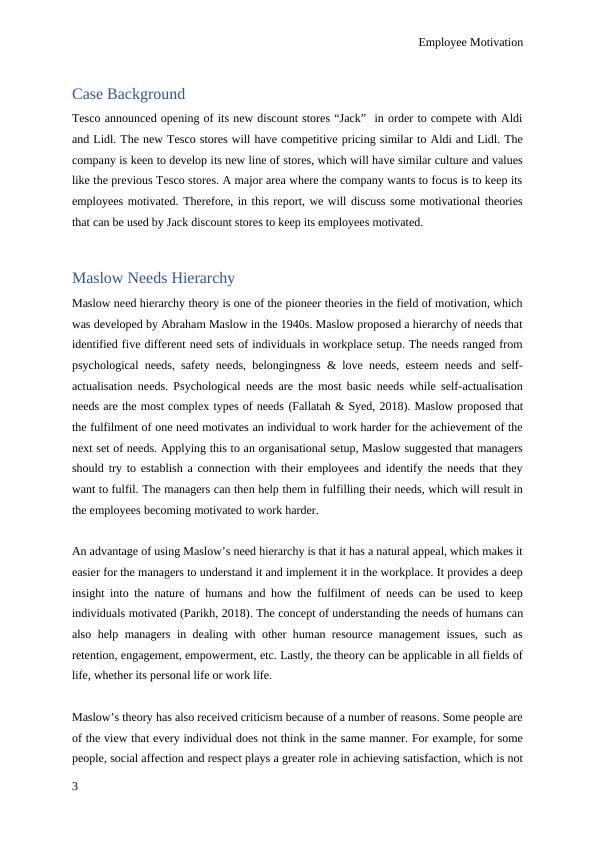Employee Motivation: Maslow's Hierarchy and Herzberg's Two Factor Theory
Added on 2023-03-20
6 Pages1405 Words97 Views
Employee Motivation
MOTIVATIONAL TECHNIQUES AT
JACK STORES – 985658
1
MOTIVATIONAL TECHNIQUES AT
JACK STORES – 985658
1

Employee Motivation
Table of Contents
Case Background...............................................................................................................3
Maslow Needs Hierarchy...................................................................................................3
Herzberg’s Two Factor Theory............................................................................................4
Conclusion.........................................................................................................................5
Bibliography......................................................................................................................6
2
Table of Contents
Case Background...............................................................................................................3
Maslow Needs Hierarchy...................................................................................................3
Herzberg’s Two Factor Theory............................................................................................4
Conclusion.........................................................................................................................5
Bibliography......................................................................................................................6
2

Employee Motivation
Case Background
Tesco announced opening of its new discount stores “Jack” in order to compete with Aldi
and Lidl. The new Tesco stores will have competitive pricing similar to Aldi and Lidl. The
company is keen to develop its new line of stores, which will have similar culture and values
like the previous Tesco stores. A major area where the company wants to focus is to keep its
employees motivated. Therefore, in this report, we will discuss some motivational theories
that can be used by Jack discount stores to keep its employees motivated.
Maslow Needs Hierarchy
Maslow need hierarchy theory is one of the pioneer theories in the field of motivation, which
was developed by Abraham Maslow in the 1940s. Maslow proposed a hierarchy of needs that
identified five different need sets of individuals in workplace setup. The needs ranged from
psychological needs, safety needs, belongingness & love needs, esteem needs and self-
actualisation needs. Psychological needs are the most basic needs while self-actualisation
needs are the most complex types of needs (Fallatah & Syed, 2018). Maslow proposed that
the fulfilment of one need motivates an individual to work harder for the achievement of the
next set of needs. Applying this to an organisational setup, Maslow suggested that managers
should try to establish a connection with their employees and identify the needs that they
want to fulfil. The managers can then help them in fulfilling their needs, which will result in
the employees becoming motivated to work harder.
An advantage of using Maslow’s need hierarchy is that it has a natural appeal, which makes it
easier for the managers to understand it and implement it in the workplace. It provides a deep
insight into the nature of humans and how the fulfilment of needs can be used to keep
individuals motivated (Parikh, 2018). The concept of understanding the needs of humans can
also help managers in dealing with other human resource management issues, such as
retention, engagement, empowerment, etc. Lastly, the theory can be applicable in all fields of
life, whether its personal life or work life.
Maslow’s theory has also received criticism because of a number of reasons. Some people are
of the view that every individual does not think in the same manner. For example, for some
people, social affection and respect plays a greater role in achieving satisfaction, which is not
3
Case Background
Tesco announced opening of its new discount stores “Jack” in order to compete with Aldi
and Lidl. The new Tesco stores will have competitive pricing similar to Aldi and Lidl. The
company is keen to develop its new line of stores, which will have similar culture and values
like the previous Tesco stores. A major area where the company wants to focus is to keep its
employees motivated. Therefore, in this report, we will discuss some motivational theories
that can be used by Jack discount stores to keep its employees motivated.
Maslow Needs Hierarchy
Maslow need hierarchy theory is one of the pioneer theories in the field of motivation, which
was developed by Abraham Maslow in the 1940s. Maslow proposed a hierarchy of needs that
identified five different need sets of individuals in workplace setup. The needs ranged from
psychological needs, safety needs, belongingness & love needs, esteem needs and self-
actualisation needs. Psychological needs are the most basic needs while self-actualisation
needs are the most complex types of needs (Fallatah & Syed, 2018). Maslow proposed that
the fulfilment of one need motivates an individual to work harder for the achievement of the
next set of needs. Applying this to an organisational setup, Maslow suggested that managers
should try to establish a connection with their employees and identify the needs that they
want to fulfil. The managers can then help them in fulfilling their needs, which will result in
the employees becoming motivated to work harder.
An advantage of using Maslow’s need hierarchy is that it has a natural appeal, which makes it
easier for the managers to understand it and implement it in the workplace. It provides a deep
insight into the nature of humans and how the fulfilment of needs can be used to keep
individuals motivated (Parikh, 2018). The concept of understanding the needs of humans can
also help managers in dealing with other human resource management issues, such as
retention, engagement, empowerment, etc. Lastly, the theory can be applicable in all fields of
life, whether its personal life or work life.
Maslow’s theory has also received criticism because of a number of reasons. Some people are
of the view that every individual does not think in the same manner. For example, for some
people, social affection and respect plays a greater role in achieving satisfaction, which is not
3

End of preview
Want to access all the pages? Upload your documents or become a member.
Related Documents
Motivation Techniques of Jacklg...
|8
|1471
|64
Motivational Techniques of Jacklg...
|6
|1371
|73
Motivation Techniques of Jacklg...
|8
|1436
|42
Motivation Techniques of Jacklg...
|8
|1567
|35
Task 3 - Case Study: Motivation Technique at Jack Storeslg...
|8
|1853
|92
Motivation Techniques of Jacklg...
|7
|1769
|78
